stop start TOYOTA COROLLA HATCHBACK 2020 (in English) Owner's Guide
[x] Cancel search | Manufacturer: TOYOTA, Model Year: 2020, Model line: COROLLA HATCHBACK, Model: TOYOTA COROLLA HATCHBACK 2020Pages: 572, PDF Size: 13.8 MB
Page 404 of 572
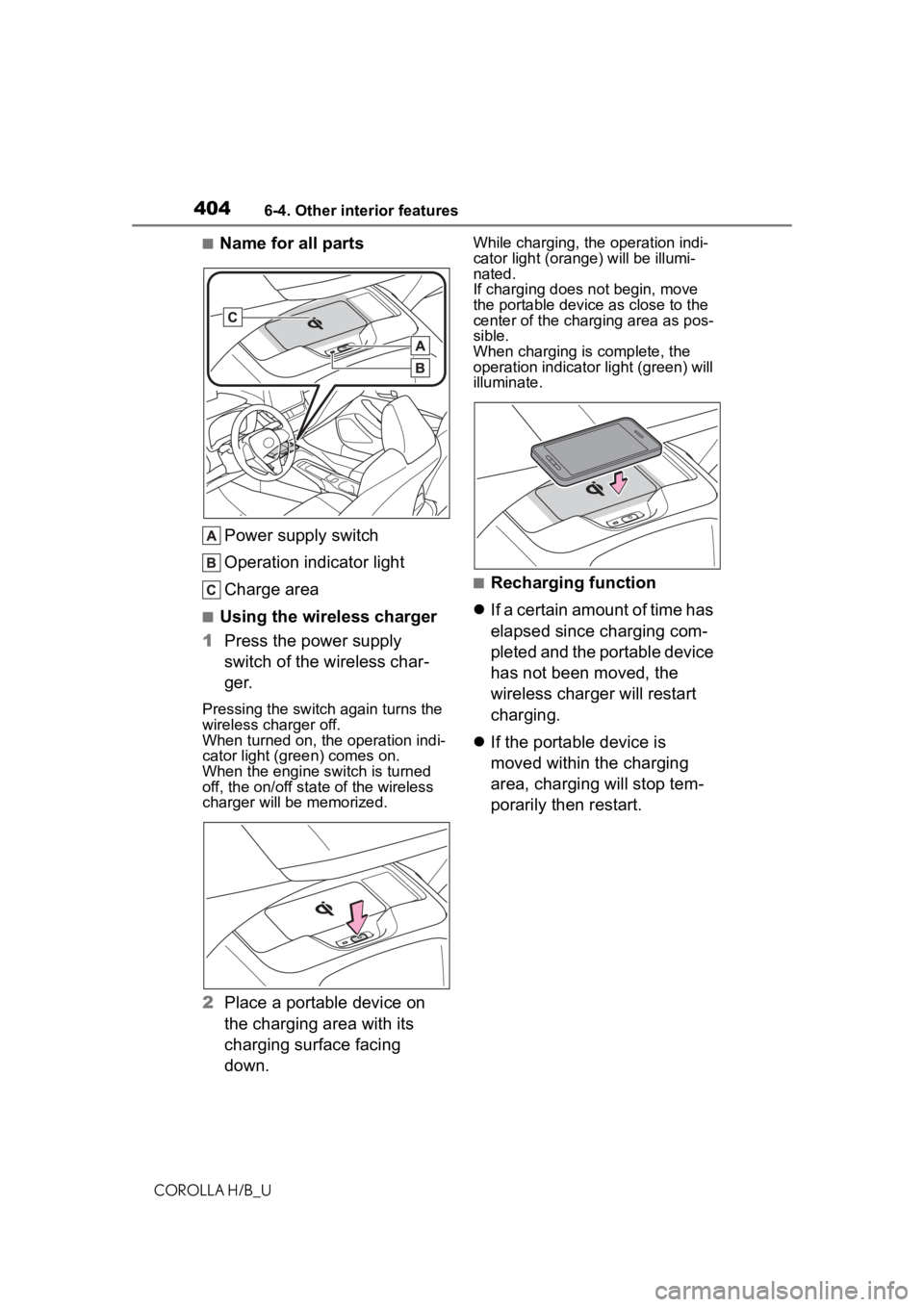
4046-4. Other interior features
COROLLA H/B_U
■Name for all partsPower supply switch
Operation indicator light
Charge area
■Using the wireless charger
1 Press the power supply
switch of the wireless char-
ger.
Pressing the switch again turns the
wireless charger off.
When turned on, the operation indi-
cator light (green) comes on.
When the engine switch is turned
off, the on/off state of the wireless
charger will be memorized.
2 Place a portable device on
the charging area with its
charging surface facing
down.
While charging, the operation indi-
cator light (oran ge) will be illumi-
nated.
If charging does not begin, move
the portable device as close to the
center of the char ging area as pos-
sible.
When charging is complete, the
operation indicato r light (green) will
illuminate.
■Recharging function
If a certain amount of time has
elapsed since charging com-
pleted and the portable device
has not been moved, the
wireless charger will restart
charging.
If the portable device is
moved within the charging
area, charging will stop tem-
porarily then restart.
Page 459 of 572

459
COROLLA H/B_U
8
8
When trouble arises
When trouble arises
.8-1. Essential informationEmergency flashers .... 460
If your vehicle has to be stopped in an emergency.................................. 460
If the vehicle is trapped in rising water ................ 461
8-2. Steps to take in an emer- gency
If your vehicle needs to be towed......................... 463
If you think something is wrong ........................ 466
Fuel pump shut off system .................................. 467
If a warning light turns on or a warning buzzer sounds.................................. 468
If a warning message is dis- played........................ 477
If you have a flat tire (vehi- cles without spare tire).................................. 479
If you have a flat tire (vehi- cles with a spare tire)
.................................. 490
If the engine will not start .................................. 498
If you lose your keys ... 500
If the electronic key does not operate properly .. 500
If the vehicle battery is dis- charged ..................... 502If your vehicle overheats
.................................. 506
If the vehicle becomes stuck .................................. 508
Page 467 of 572

4678-2. Steps to take in an emergency
COROLLA H/B_U
8
When trouble arises
side when braking
Vehicle pulls heavily to one
side when driving on a level
road
Loss of brake effectiveness,
spongy feeling, pedal almost
touches the floor
Follow the procedure below to
restart the engine after the sys-
tem is activated.
1Turn the engine switch to
ACC or OFF.
2 Restart the engine.Fuel pump shut off
system
To minimize the risk of fuel
leakage when the engine
stalls or when an airbag
inflates upon collision, the
fuel pump shut off system
stops the supply of fuel to
the engine.
Restarting the engine
NOTICE
■Before starting the engine
Inspect the ground under the
vehicle.
If you find that fuel has leaked
onto the ground, the fuel system
has been damaged and is in need
of repair. Do not restart the
engine.
Page 476 of 572
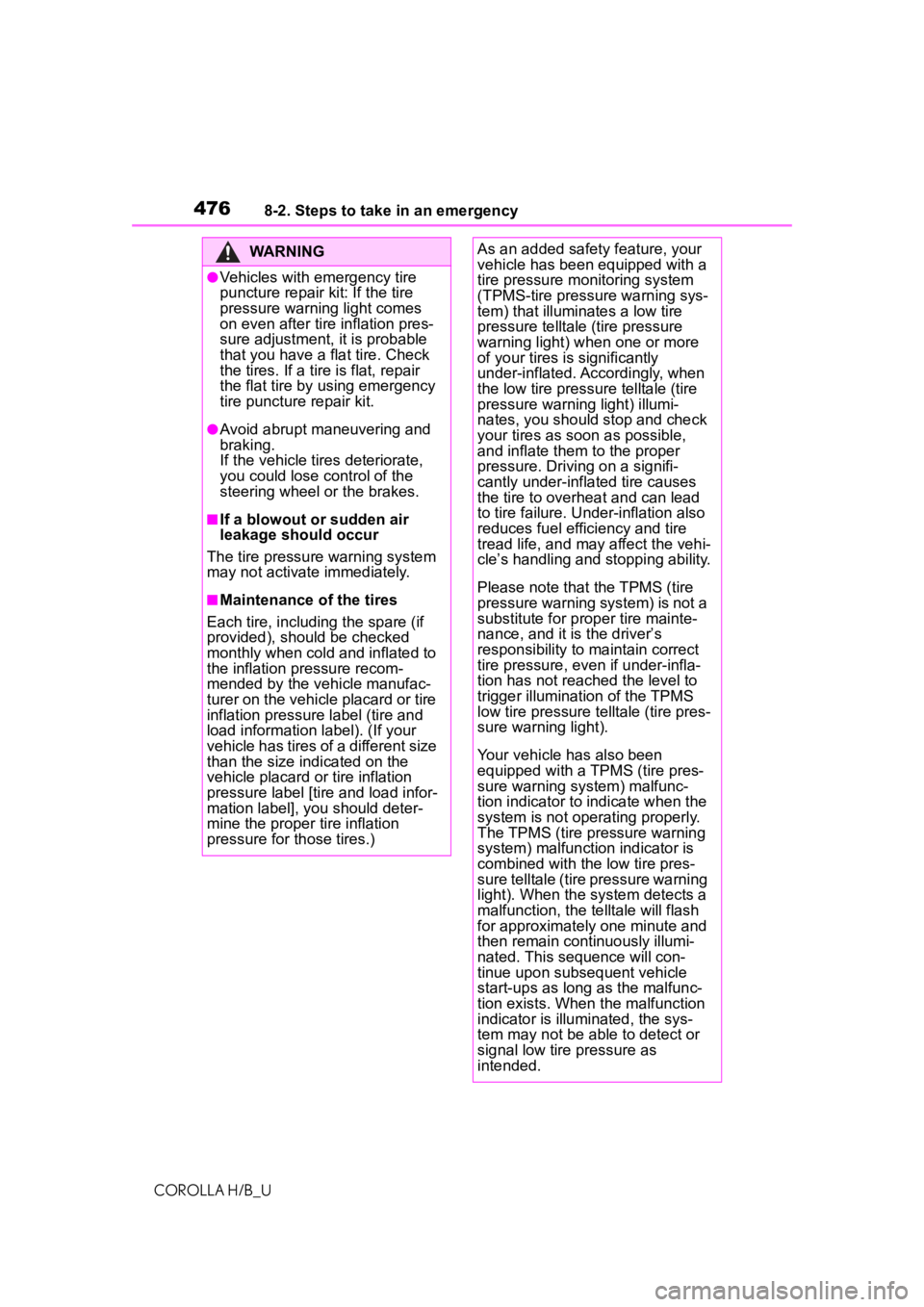
4768-2. Steps to take in an emergency
COROLLA H/B_U
WARNING
●Vehicles with emergency tire
puncture repair kit: If the tire
pressure warning light comes
on even after tire inflation pres-
sure adjustment, it is probable
that you have a flat tire. Check
the tires. If a tire is flat, repair
the flat tire by using emergency
tire puncture repair kit.
●Avoid abrupt maneuvering and
braking.
If the vehicle tires deteriorate,
you could lose control of the
steering wheel or the brakes.
■If a blowout or sudden air
leakage should occur
The tire pressure warning system
may not activate immediately.
■Maintenance of the tires
Each tire, including the spare (if
provided), should be checked
monthly when cold and inflated to
the inflation pressure recom-
mended by the vehicle manufac-
turer on the vehicle placard or tire
inflation pressure label (tire and
load information label). (If your
vehicle has tires of a different size
than the size indicated on the
vehicle placard or tire inflation
pressure label [tire and load infor-
mation label], you should deter-
mine the proper tire inflation
pressure for those tires.)
As an added safety feature, your
vehicle has been equipped with a
tire pressure monitoring system
(TPMS-tire pressure warning sys-
tem) that illuminates a low tire
pressure telltale (tire pressure
warning light) w hen one or more
of your tires is significantly
under-inflated. Accordingly, when
the low tire pressure telltale (tire
pressure warning light) illumi-
nates, you should stop and check
your tires as soon as possible,
and inflate them to the proper
pressure. Driving on a signifi-
cantly under-inflated tire causes
the tire to overhea t and can lead
to tire failure. Under-inflation also
reduces fuel efficiency and tire
tread life, and may affect the vehi-
cle’s handling and stopping ability.
Please note that the TPMS (tire
pressure warning system) is not a
substitute for proper tire mainte-
nance, and it is the driver’s
responsibility to m aintain correct
tire pressure, even if under-infla-
tion has not reached the level to
trigger illumination of the TPMS
low tire pressure te lltale (tire pres-
sure warning light).
Your vehicle has also been
equipped with a TPMS (tire pres-
sure warning system) malfunc-
tion indicator to indicate when the
system is not operating properly.
The TPMS (tire pressure warning
system) malfunction indicator is
combined with the low tire pres-
sure telltale (tire pressure warning
light). When the system detects a
malfunction, the te lltale will flash
for approximately one minute and
then remain continuously illumi-
nated. This sequence will con-
tinue upon subsequent vehicle
start-ups as long as the malfunc-
tion exists. When the malfunction
indicator is illuminated, the sys-
tem may not be ab le to detect or
signal low tire pressure as
intended.
Page 478 of 572

4788-2. Steps to take in an emergency
COROLLA H/B_Unecessary.
This message may appear if the
vehicle is stopped on a slope. Move
the vehicle to a level surface and
check to see if the message disap-
pears.
■If “Engine Stopped Steering
Power Low” is displayed
This message is displayed if the
engine is stopped while driving.
When steering wheel operations are
heavier than usual, grip the steering
wheel firmly and operate it using
more force th an usual.
■If “Auto Power OFF to Conserve
Battery” is displayed
Power was cut off due to the auto-
matic power off function. Next time
when starting the engine, increase
the engine speed slightly and main-
tain that level for approximately 5
minutes to recha rge the battery.
■If “Headlight System Malfunc-
tion Visit Your Dealer” is dis-
played
The following systems may be mal-
functioning. Have the vehicle
inspected by your Toyota dealer
immediately.
●The LED headlight system
●AFS (Adaptive Fr ont-lighting Sys-
tem) (if equipped)
●The automatic headlight leveling
system (if equipped)
●Automatic High Beam (if
equipped)
■If “Front Camera Unavailable”
or “Front Camera Unavailable
See Owner’s Manual” is dis-
played
The following sys tems may be sus-
pended until the pr oblem shown in
the message is resolved. ( P.176,
468)
●PCS (Pre-Collision system)
●LTA (Lane Tracing Assist) (if
equipped)
●LDA (Lane Departure Alert with
steering control) (if equipped)
●Automatic High Beam (if
equipped)
●RSA (Road Sign Assist) (if
equipped)
●Dynamic radar cruise control with
full-speed range (if equipped)
●Dynamic radar cruise control (if
equipped)
■If “Radar Cruise Control
Unavailable” is displayed
The dynamic radar cruise control
with full-speed range system or
dynamic radar cruise control system
cannot be used temporarily. Use the
system when it becomes available
again.
■If “Maintenance Required
Soon” is displayed
Indicates that all maintenance
according to the driven distance on
the maintenance schedule
* should
be performed soon.
Comes on approximately 4500
miles (7200 km) after the message
has been reset. If necessary, per-
form maintenance. Please reset the
message after the maintenance is
performed. ( P.420)
*: Refer to the separate “Scheduled
Maintenance” or “Owner’s Man-
ual Supplement” for the mainte-
nance interval applicable to your
vehicle.
■If “Maintenance Required Visit
Your Dealer” is displayed
Indicates that all maintenance is
required to correspond to the driven
distance on the maintenance sched-
ule
*.
Comes on approximately 5000
miles (8000 km) after the message
has been reset. (The indicator will
not work properly unless the mes-
sage has been rese t.) Perform the
necessary maintenance. Please
Page 502 of 572
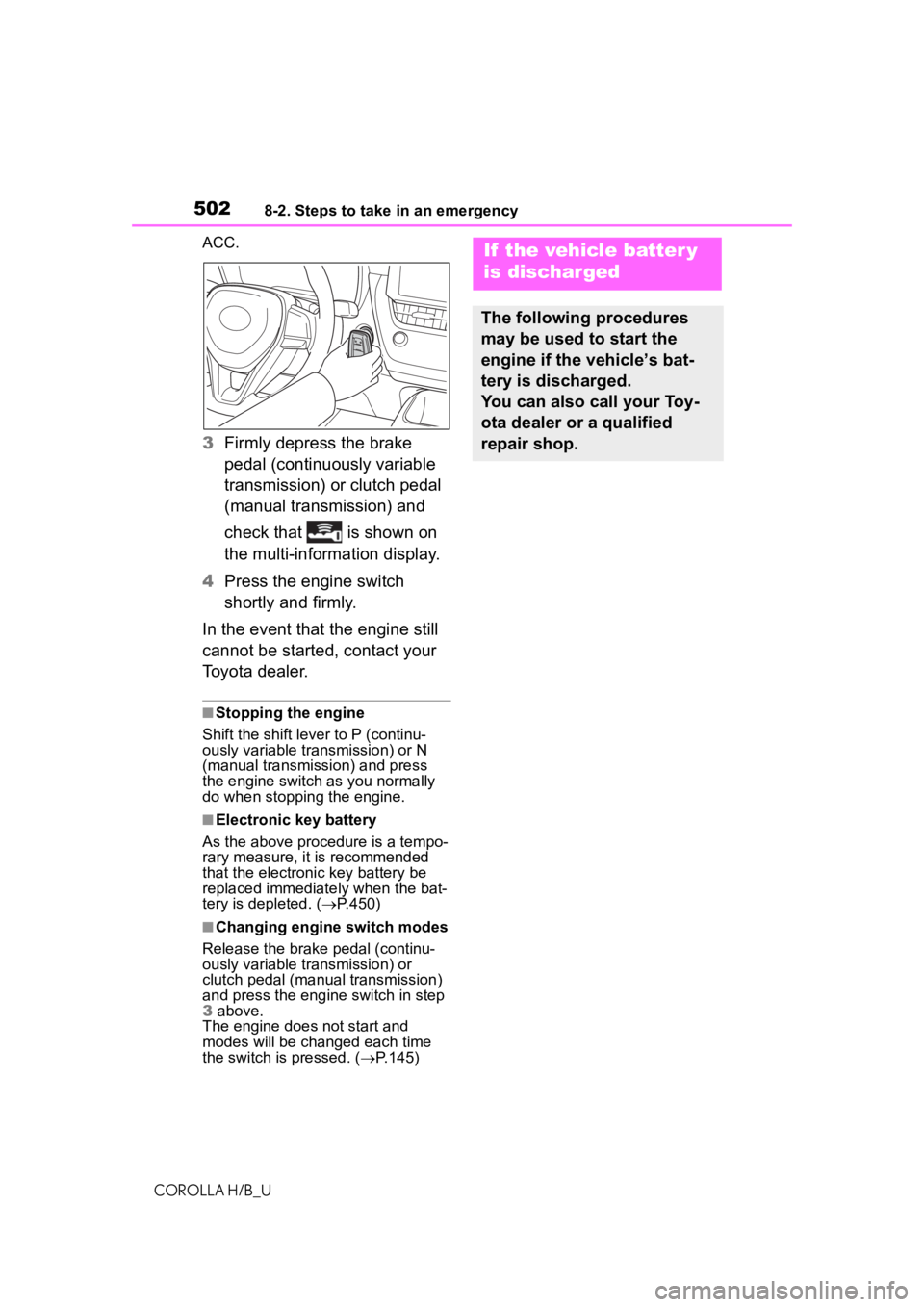
5028-2. Steps to take in an emergency
COROLLA H/B_UACC.
3
Firmly depress the brake
pedal (continuously variable
transmission) or clutch pedal
(manual transmission) and
check that is shown on
the multi-information display.
4 Press the engine switch
shortly and firmly.
In the event that the engine still
cannot be started, contact your
Toyota dealer.
■Stopping the engine
Shift the shift lever to P (continu-
ously variable transmission) or N
(manual transmission) and press
the engine switch as you normally
do when stopping the engine.
■Electronic key battery
As the above proc edure is a tempo-
rary measure, it is recommended
that the electronic key battery be
replaced immediate ly when the bat-
tery is depleted. ( P.450)
■Changing engine switch modes
Release the brake pedal (continu-
ously variable transmission) or
clutch pedal (manual transmission)
and press the engine switch in step
3 above.
The engine does not start and
modes will be cha nged each time
the switch is pressed. ( P.145)
If the vehicle batter y
is discharged
The following procedures
may be used to start the
engine if the vehicle’s bat-
tery is discharged.
You can also call your Toy-
ota dealer or a qualified
repair shop.
Page 507 of 572
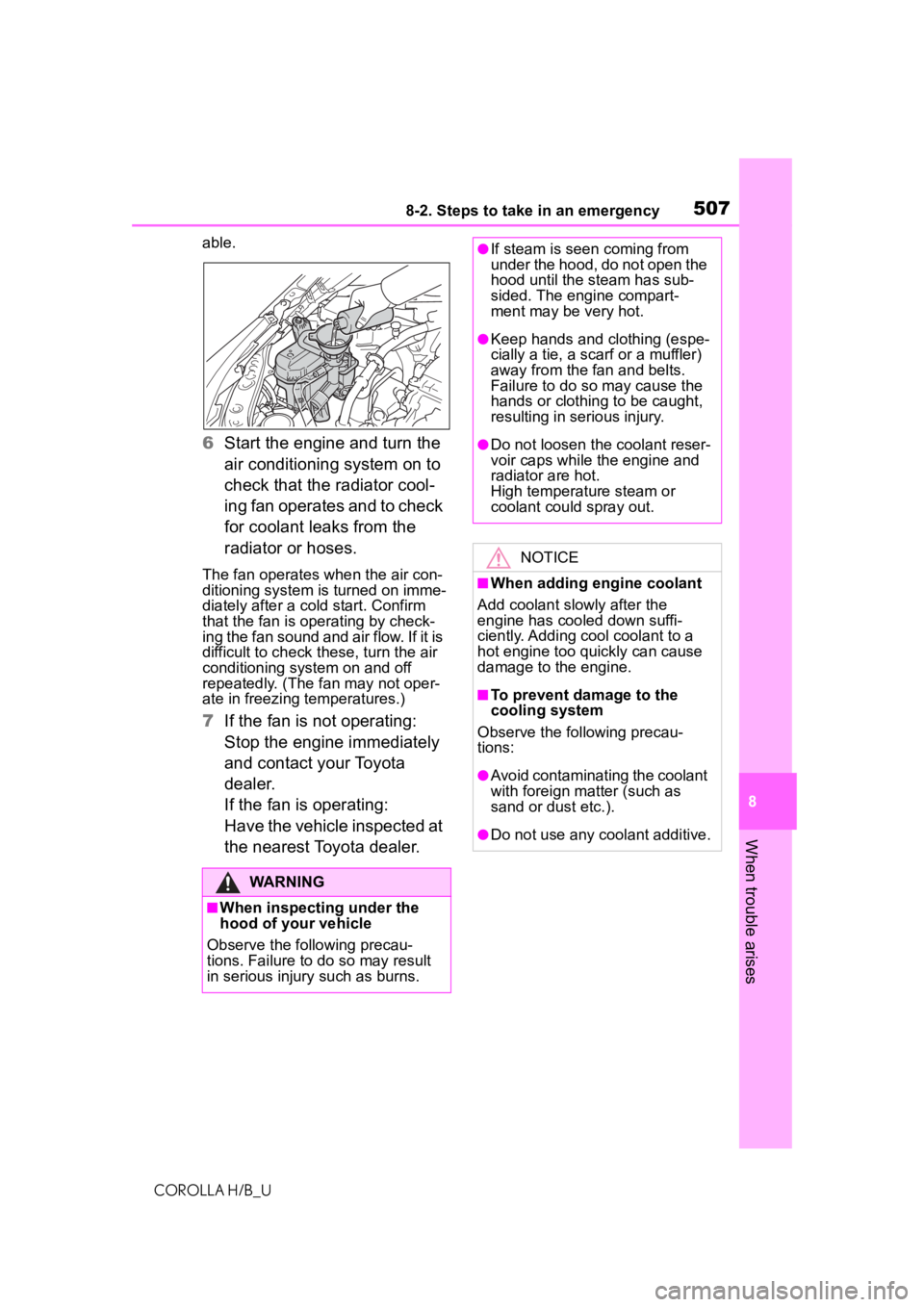
5078-2. Steps to take in an emergency
COROLLA H/B_U
8
When trouble arises
able.
6 Start the engine and turn the
air conditioning system on to
check that the radiator cool-
ing fan operates and to check
for coolant leaks from the
radiator or hoses.
The fan operates when the air con-
ditioning system is turned on imme-
diately after a cold start. Confirm
that the fan is op erating by check-
ing the fan sound and air flow. If it is
difficult to check these, turn the air
conditioning system on and off
repeatedly. (The fan may not oper-
ate in freezing temperatures.)
7 If the fan is not operating:
Stop the engine immediately
and contact your Toyota
dealer.
If the fan is operating:
Have the vehicle inspected at
the nearest Toyota dealer.
WARNING
■When inspecting under the
hood of your vehicle
Observe the following precau-
tions. Failure to do so may result
in serious injury such as burns.
●If steam is seen coming from
under the hood, do not open the
hood until the steam has sub-
sided. The engine compart-
ment may be very hot.
●Keep hands and clothing (espe-
cially a tie, a sca rf or a muffler)
away from the fan and belts.
Failure to do so may cause the
hands or clothing to be caught,
resulting in serious injury.
●Do not loosen the coolant reser-
voir caps while the engine and
radiator are hot.
High temperature steam or
coolant could spray out.
NOTICE
■When adding engine coolant
Add coolant slowly after the
engine has cooled down suffi-
ciently. Adding cool coolant to a
hot engine too quickly can cause
damage to the engine.
■To prevent damage to the
cooling system
Observe the following precau-
tions:
●Avoid contaminating the coolant
with foreign matter (such as
sand or dust etc.).
●Do not use any coolant additive.
Page 508 of 572

5088-2. Steps to take in an emergency
COROLLA H/B_U
1Stop the engine. Set the
parking brake and shift the
shift lever to P (continuously
variable transmission) or N
(manual transmission).
2 Remove the mud, snow or
sand from around the front
wheels.
3 Place wood, stones or some
other material under the front
wheels to help provide trac-
tion.
4 Restart the engine.
5 Shift the shift lever to D or R
(continuously variable trans-
mission) or 1 or R (manual
transmission) and release
the parking brake. Then,
while exercising caution,
depress the accelerator
pedal.
■When it is difficult to free the
vehicle
Press the switch to turn off
TRAC.
If the vehicle becomes
stuck
Carry out the following pro-
cedures if the tires spin or
the vehicle becomes stuck
in mud, dirt or snow:
Recovering procedure
WARNING
■When attempting to free a
stuck vehicle
If you choose to push the vehicle
back and forth to free it, make
sure the surrounding area is clear
to avoid striking other vehicles,
objects or people. The vehicle
may also lunge forward or lunge
back suddenly as it becomes free.
Use extreme caution.
■When shifting the shift lever
(vehicles with a continuously
variable transmission)
Be careful not to shift the shift
lever with the accelerator pedal
depressed.
This may lead to unexpected
rapid acceleration of the vehicle
that may cause an accident
resulting in death o r serious injury.
NOTICE
■To avoid damaging the trans-
mission and other compo-
nents
●Avoid spinning the front wheels
and depressing the accelerator
pedal more than necessary.
●If the vehicle remains stuck
even after these procedures are
performed, the vehicle may
require towing to be freed.
Page 553 of 572
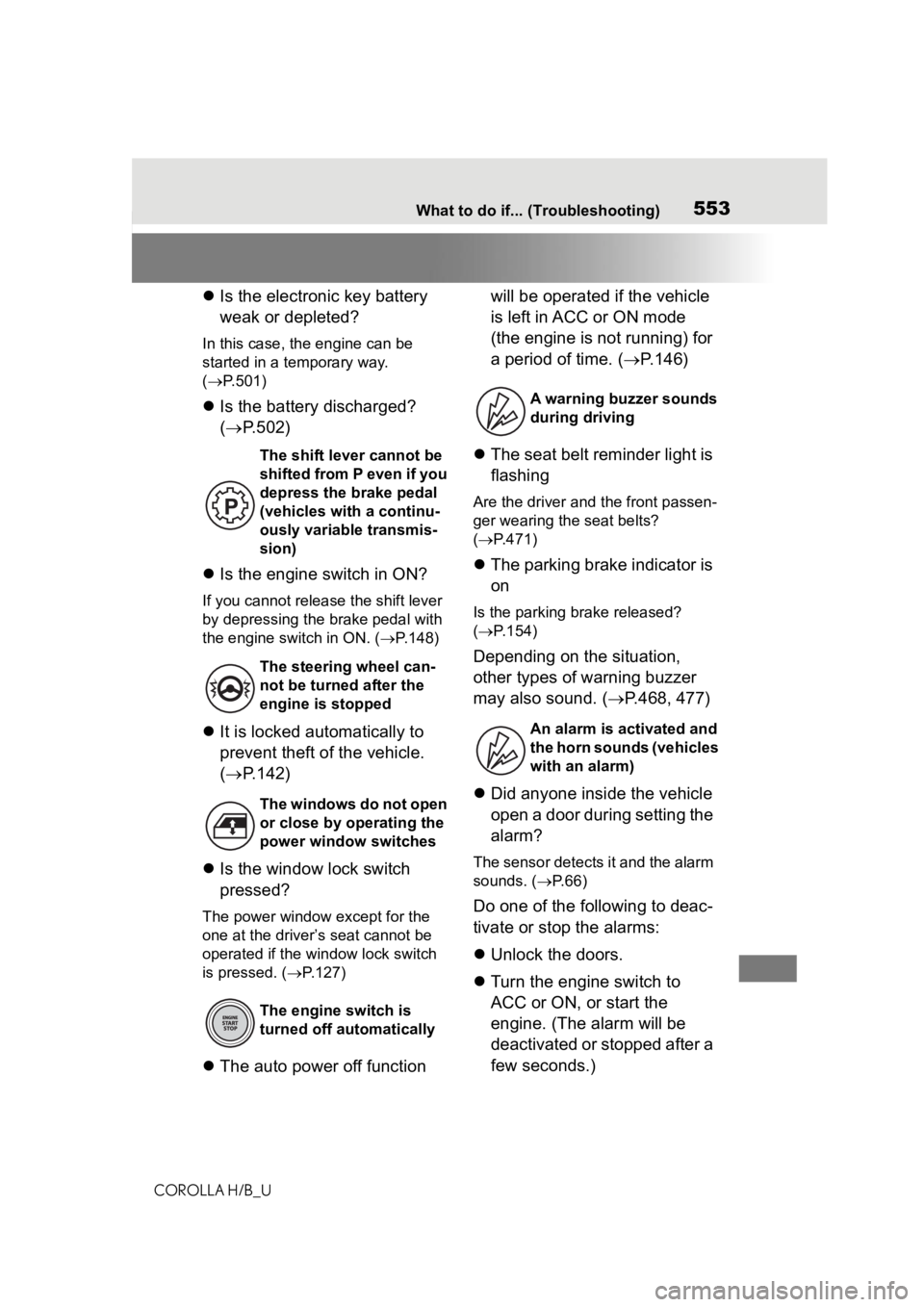
553What to do if... (Troubleshooting)
COROLLA H/B_U
Is the electronic key battery
weak or depleted?
In this case, the engine can be
started in a temporary way.
( P.501)
Is the battery discharged?
( P.502)
Is the engine switch in ON?
If you cannot release the shift lever
by depressing the brake pedal with
the engine switch in ON. ( P.148)
It is locked automatically to
prevent theft of the vehicle.
( P.142)
Is the window lock switch
pressed?
The power window except for the
one at the driver’s seat cannot be
operated if the win dow lock switch
is pressed. ( P.127)
The auto power off function will be operated if the vehicle
is left in ACC or ON mode
(the engine is not running) for
a period of time. (
P.146)
The seat belt reminder light is
flashing
Are the driver and the front passen-
ger wearing the seat belts?
( P.471)
The parking brake indicator is
on
Is the parking br ake released?
( P.154)
Depending on the situation,
other types of warning buzzer
may also sound. ( P.468, 477)
Did anyone inside the vehicle
open a door during setting the
alarm?
The sensor detects it and the alarm
sounds. ( P. 6 6 )
Do one of the following to deac-
tivate or stop the alarms:
Unlock the doors.
Turn the engine switch to
ACC or ON, or start the
engine. (The alarm will be
deactivated or stopped after a
few seconds.)
The shift lever cannot be
shifted from P even if you
depress the brake pedal
(vehicles with a continu-
ously variable transmis-
sion)
The steering wheel can-
not be turned after the
engine is stopped
The windows do not open
or close by operating the
power window switches
The engine switch is
turned off automatically
A warning buzzer sounds
during driving
An alarm is activated and
the horn sounds (vehicles
with an alarm)
Page 558 of 572

558Alphabetical Index
COROLLA H/B_U
Side doors ............................ 101
Drive distance ........................... 86
Drive information ..................... 86
Drive-start control .................. 132
Driving Break-in tips ......................... 132
Correct driving posture ........... 23
Driving mode select switch... 240
Procedures ........................... 130
Winter drive tips ................... 246
Driving information display ..... 84
Driving range ...................... 84, 85
Driving support system informa- tion display ............................. 86
Dynamic radar cruise control 214 Warning message ................ 222
Dynamic radar cruise control with full-speed range ........... 204Warning message ................ 213
E
Eco Driving Indicator ......... 85, 92
Eco Driving Indicator Light ..... 85
EDR (Event data recorder)......... 8
Elapsed time ............................. 86
Electric Power Steering (EPS) ............................................... 241Warning light ........................ 471
Electronic key ........................... 98 Battery-saving function......... 109
If the electronic key does not operate properly ................. 500
Replacing the battery ........... 450
Emergency flashers ............... 460
Emergency tire puncture repair kit ........................................... 479
Emergency, in case of If a warning buzzer sounds .. 468
If a warning light turns on ..... 468
If a warning message is dis-played................................. 477
If the battery is discharged ... 502 If the electronic key does not
operate properly .................500
If the engine will not start......498
If the vehicle is trapped in rising water...................................461
If you have a flat tire .............479
If you lose your keys.............500
If you think something is wrong ...........................................466
If your vehicle becomes stuck ...........................................508
If your vehicle has to be stopped in an emergency .................460
If your vehicle needs to be towed ...........................................463
If your vehicle ove rheats ......506
Engine ACCESSORY mode . ............145
Compartment........................429
Engine switch .......................142
Fuel pump shut off system ...467
Hood .....................................427
How to start the engine ........142
Identification number ............ 511
If the engine will not start......498
If your vehicle has to be stopped in an emergency .................460
Ignition switch (engine switch) ...........................................142
Overheating .........................506
Tachometer.......................74, 78
Engine coolant Capacity ...............................513
Checking ..............................431
Preparing and checking before winter ..................................246
Engine coolant temperature gauge .................................74, 78
Engine immobilizer system .....64
Engine oil Capacity ............................... 511
Checking ..............................429